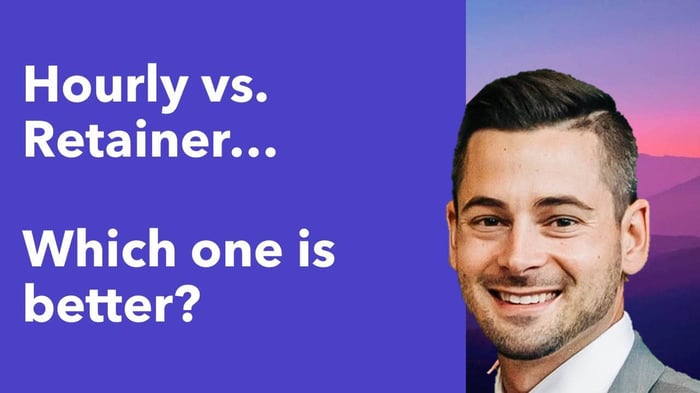Intro
Ah yes, the age-old question.
Should I charge by the hour or a monthly retainer?
The truth is they both have their ups-and-downs.
Let's talk through them below...
Pros of an hourly rate:
Flexibility: Hourly billing allows for flexibility in terms of the amount of work that is performed. This can be beneficial if the scope of the project is not well defined or if the client's needs are constantly changing. In other words, you can avoid "scope creep" which is very common on projects.
Transparent pricing: The client can see exactly how much they are being charged for each installment of time. This can help build trust and establish a clear understanding of the value being provided.
Lower risk: The provider is not committing to a fixed amount of work, which can be beneficial if the project is risky or uncertain.
Cons of an hourly rate:
Difficulty in forecasting: It can be challenging for clients to predict the total cost of a project when billing is done on an hourly basis. This can make it difficult for them to budget for the work and may lead to sticker shock if the final invoice is higher than expected. I've got a little more on this below.
Potential for misunderstandings: If the scope of the work is not clearly defined, there is a risk of misunderstandings or disputes over the amount of work that is being billed.
Technology / Efficiency: As you make technological improvements and get better at your job, it typically takes you less time to complete the same work.
Pros of a monthly retainer:
Predictable pricing: A monthly retainer provides the client with a predictable cost for the services being provided. This can make budgeting and planning easier for the client.
Long-term commitment: A monthly retainer can signify a long-term commitment between the provider and the client, which can be beneficial for building a strong working relationship.
Relationship-building: A monthly retainer can allow for more frequent communication and collaboration, which can lead to a better understanding of the client's needs and preferences.
Up-front billing: A client can be on auto-debit and pay you upfront each month instead of you invoicing after the work is completed and potentially having to chase down Accounts Receivable.
Cons of a monthly retainer:
Limited flexibility: With a monthly retainer, the provider is committing to a fixed amount of work, which can be inflexible if the client's needs change or the scope of the project expands.
Abuse of time: Some clients can take advantage of the monthly fee and demand a lot of hours on a poorly-scoped project, which can lead to a low hourly rate (on a net basis) and frustration for the service provider. This is the primary risk in my opinion.
Risk of overpayment: If the client's needs change or the scope of the project decreases, the client may overpay for the work being done.
What I Do
Me personally? I still bill hourly and have been doing it for several years.
I do this because I feel like financial modeling projects are often uncertain and very hard to scope.
Once you get in the weeds, something new always pops up and the scope changes.
So, I like to avoid the "scope and time" conversation and just get the work done, whatever it takes.
My solution for price expectations is to send an "average cost sheet," which I've copied below:

But, you can see the uncertainty here directly: I make a disclaimer that it's an average and the actual cost may differ materially. That's just the nature of hourly work and this can turn some people off.
What I See Others Do
Based on chats I've had, I believe I am the exception.
Most people I've spoken with use the monthly retainer model and they say it's better than hourly all around, and they're willing to take on the "Abuse of time" risk.
Initially it sounds like heavy hours for a new project but then it evens out over the longer term, and truthfully I can see the benefit.
Retainers absolutely promote efficient work through investments in technology and templates, and the nature of the recurring billing brings peace of mind.
Action Items
At the end of the day it will come down to what's best for you and brings you peace of mind.
If you're brand new I would propose starting with charging hourly just to gather some data.
You're looking to see how much time projects typically take and what your client's problems are.
From there, if you can start to establish a pattern and/or build some systems around your work, I think switching over to a retainer might be a nice idea.
Ultimately the trade-off comes down to the investment of your time and predictability of income, and that's up to you.
That's it for today. See you next time.
—Chris
How I Can Help Further...
As finance professionals there's one thing we all have in common -- our financial modeling skills need to be dialed.
If you need to refresh or sharpen your modeling skills, you can learn to build the exact models I use with FP&A and Private Equity firms around the world.

